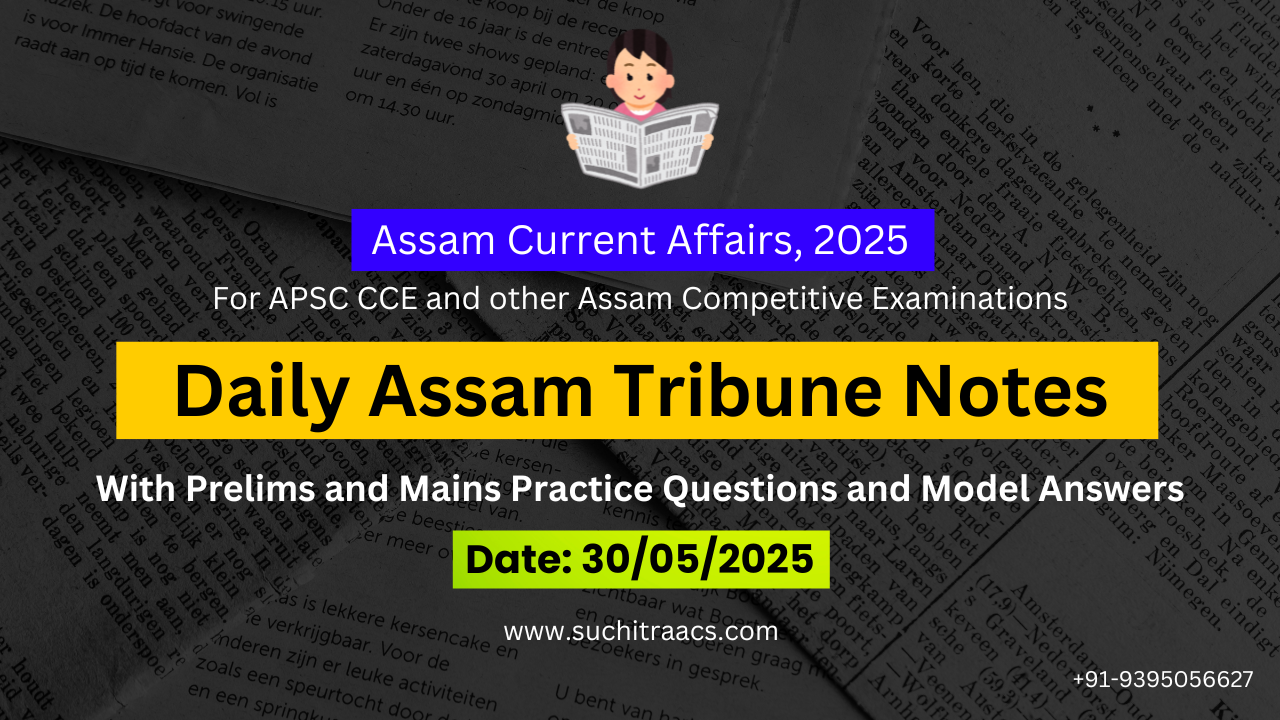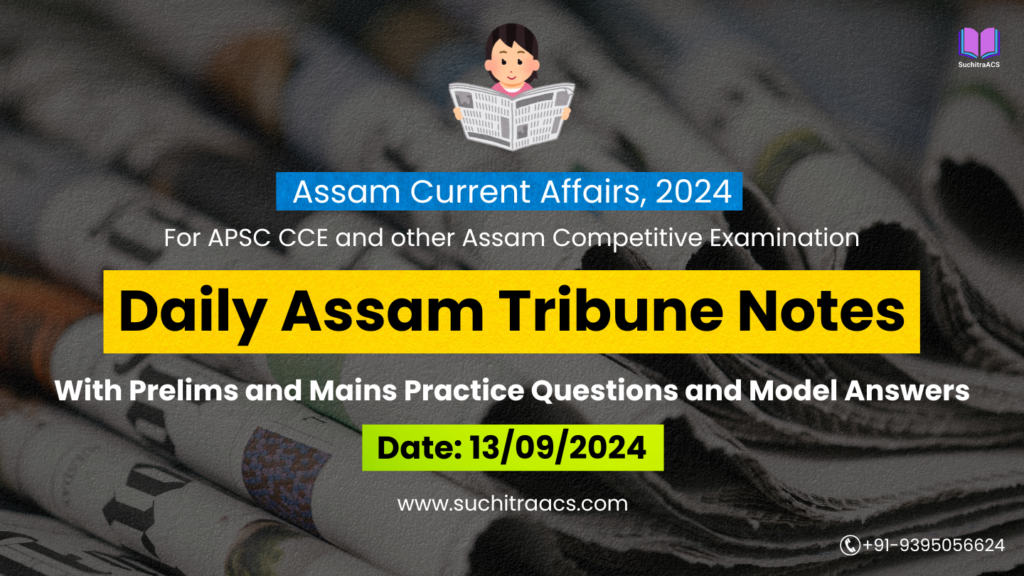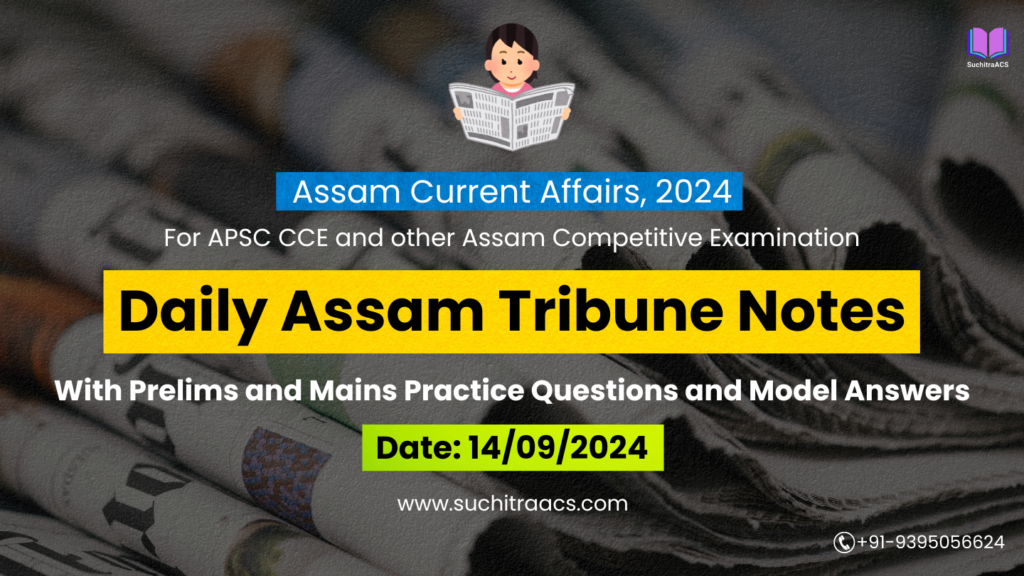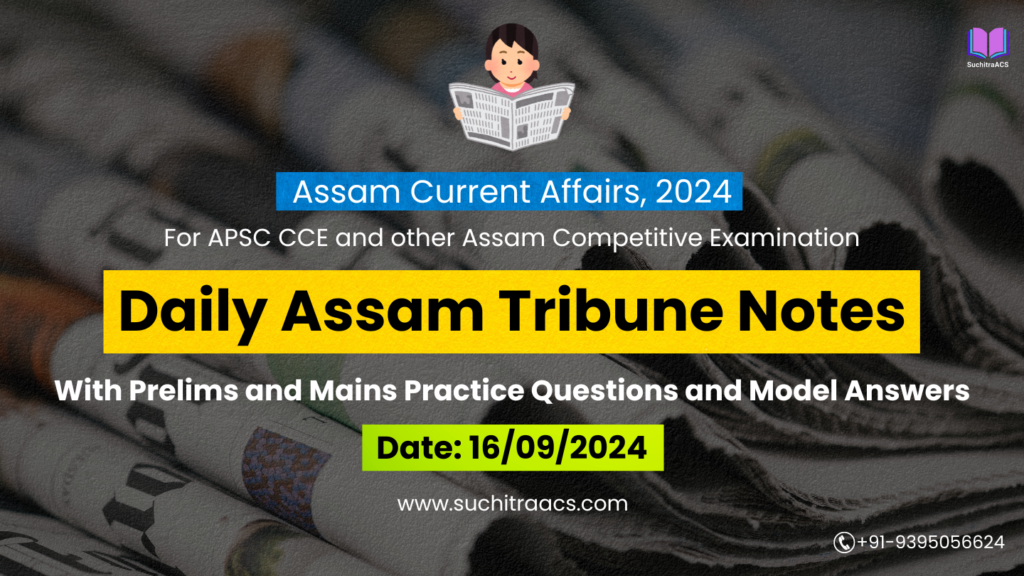APSC Current Affairs: Assam Tribune Notes with MCQs and Answer Writing (30/05/2025)
For APSC CCE and other Assam Competitive examinations aspirants, staying updated with current affairs is vital. This blog covers most important topics from the Assam Tribune today (30-05-2025). These issues are key for both APSC Prelims and Mains preparation, offering insights into the APSC CCE Syllabus.
✨ APSC CCE Online Coaching, 2026

🌊 China’s Mega Dam Plans and India’s Brahmaputra Water Security
(Source: Interview with river expert Prof. Nayan Sharma)
📘 GS Paper 2: International Relations | India-China Relations | Environmental Agreements
📘 GS Paper 3: Disaster Management | Water Resources | Environmental Security
📘 GS Paper 5 (APSC): Assam Environment | Geography | Hydrological Challenges
🔹 Introduction
India and China share multiple transboundary rivers, but lack a formal water-sharing treaty, particularly concerning the Brahmaputra (Yarlung Tsangpo). Recent revelations about China’s plan to build a 60,000 MW hydroelectric dam in the Great Bend Canyon of the Yarlung Tsangpo in Tibet raise serious concerns about India’s water security, ecological stability, and flood vulnerability, especially in Assam.
🔑 Key Points
| Feature | Details |
| Proposed by | China (State-owned Hydropower Developer) |
| Location | Great Bend Canyon (Yarlung Tsangpo, Tibet) |
| Project Capacity | 60,000 MW (one of the world’s largest hydropower projects) |
| Cost | ~USD 137 billion |
| Indian Riparian Position | Lower riparian state; highly vulnerable due to absence of treaty |
| Expert Recommendation | Build decentralized storage infrastructure in Brahmaputra tributaries |
⚠️ Potential Impacts on Assam and India
| Impact Type | Implication |
| Water Scarcity | Risk of choking flow during lean season affecting irrigation, drinking water, hydropower in NE India |
| Flood Vulnerability | Dam-induced sudden releases can amplify monsoon floods in Assam and destabilize bridge piers |
| Climate Disruption | Increased runoff due to snowmelt reduction and monsoon unpredictability |
| Geopolitical Risk | China’s unilateral control over river flow; precedent of similar action in the Mekong River |
| Ecological Damage | Alteration of sediment flow, impact on aquatic biodiversity, riverine ecosystems in Assam |
🧠 Prelims Pointers
Yarlung Tsangpo: The upper stream of the Brahmaputra River in Tibet
CUMEC: Cubic meters per second; used to measure river discharge
Great Bend Canyon: Location where Yarlung takes a U-turn into Arunachal Pradesh
Brahmaputra Discharge: Max recorded at Pandu (72,779 cumec in 1962); min (1,757 cumec in 1968)
Snowmelt Contribution: Only 6% of Brahmaputra’s annual water yield
India-China Water Treaty: None exists despite being riparian neighbours
Mekong Committee: China refused to join; signals reluctance to engage in binding treaties
📝 Mains Pointers
A. Significance of the Issue
Affects Assam’s agricultural planning, hydroelectric projects, and disaster management
Has bearing on India-China bilateral relations and water diplomacy in Asia
Exposes the absence of global enforcement mechanisms for transboundary river disputes
B. Challenges
| Challenge | Description |
| No Binding Treaty | China refuses to engage in water-sharing frameworks |
| Climate Variability | Unpredictable monsoon and declining snowmelt patterns |
| Ecological Fragility | Assam’s floodplains are highly sensitive to flow variability |
| Infrastructure Readiness | Lack of water storage infrastructure in upper Brahmaputra tributaries |
| Diplomatic Stalemate | UN and regional diplomacy (e.g. Mekong case) have had limited influence on China |
C. Government Responses and Options
Continuous hydrological data sharing agreements (non-binding) with China
Use of space-based satellite monitoring of Chinese dam activity
Encourage bilateral diplomatic talks under the ‘benefit sharing’ principle
Promote regional river basin cooperation (e.g. with Bhutan & Bangladesh)
Proposal to build medium-scale dams on over 100 Brahmaputra tributaries to ensure buffer capacity during lean flow
D. Way Forward
🛠️ Develop multi-purpose storage structures on tributaries
🌐 Internationalize the Brahmaputra issue under the UN Watercourses Convention (India is not a signatory yet)
🤝 Use Track-II diplomacy (academia, think tanks, multilateral forums) to engage China
📡 Invest in early warning systems, real-time flow monitoring, and climate modeling
🌱 Integrate river management under Assam’s Disaster Resilience & Climate Plans
📑 Relevant Reports & Frameworks
National Water Policy (2012) – promotes integrated water management
UN Convention on the Law of the Non-Navigational Uses of International Watercourses (1997)
World Bank Study on Brahmaputra Basin (2021)
Assam State Action Plan on Climate Change (SAPCC)
NITI Aayog Report on Himalayan River Basins (2020)
🧩 Conclusion
The threat posed by China’s mega dam on the Yarlung Tsangpo is not just geopolitical—it is a water, environmental, and human security challenge for Assam and India. In the absence of a treaty, India must proactively build climate-resilient infrastructure, invest in diplomacy, and deepen basin-level cooperation with neighboring countries. Assam’s future may well depend on how seriously we act today.
🚧 Assam-Meghalaya Border Dispute: Renewed Efforts for Peace
📘 GS Paper 2: Federalism | Inter-State Relations | Boundary Issues
📘 GS Paper 5 (APSC): Polity and Governance in Assam | Border Issues in the Northeast
🔹 Introduction
The Chief Ministers of Assam and Meghalaya are set to meet on June 2, 2025, to advance talks on resolving the remaining six areas of boundary dispute. This follows the 2022 MoU that resolved six out of twelve disputed areas. However, issues remain in sensitive regions like Block I & II, Langpih, and Psiar-Khanduli, which require intricate negotiations involving community sentiments, administrative records, and geographical claims.
🔑 Key Points
| Feature | Details |
| Meeting Date | June 2, 2025 |
| Level of Talks | Chief Minister-level dialogue |
| Dispute Origin | Arises from 1972 state reorganization when Meghalaya was carved out of Assam |
| Previous Resolution | March 2022 MoU settled 6 areas: Tarabari, Gizang, Hahim, Boklapara, Khanapara-Pillangkata, Ratacheera |
| Remaining Areas | Block I & II, Psiar-Khanduli, Borduar, Nongwah-Mawtamur, Deshdoomreah (Ri-Bhoi), Langpih (West Khasi Hills) |
| Dispute Area Size (2022 phase) | ~36.79 sq. km shared; Meghalaya got 18.28 sq. km, Assam 18.51 sq. km |
⚠️ Core Dispute Factors
Historical Claims (colonial-era maps, 1870s-80s boundary lines)
Tribal Sentiments (Khasi, Garo, Karbi communities involved)
Administrative Control (many villages governed by one state, but claimed by another)
Geographical Contiguity and Land Records conflicts
🧠 Prelims Pointers
Langpih Issue: A flashpoint—controlled by Assam but claimed by Meghalaya; site of past skirmishes.
State Reorganization Act, 1971: Created Meghalaya, leading to territorial ambiguities.
Article 131: Empowers SC to settle inter-state disputes but states often prefer political resolution.
Survey of India: Involved in demarcating the boundary after MoU.
Hill Areas: Sixth Schedule applies to Meghalaya; autonomous councils play a role in ground-level claims.
📝 Mains Pointers
A. Importance of the Dialogue
Reduces ethnic tensions and avoids flare-ups like Mukroh firing incident (2022)
Improves Centre-State coordination on internal security
Enhances trust between governments and local stakeholders
Essential for development of border villages in disputed zones
Creates precedent for resolving other NE border disputes (e.g., Assam-Mizoram, Assam-Arunachal)
B. Challenges
| Challenge | Explanation |
| Competing Land Claims | Based on different records/maps (British era vs post-Independence) |
| Local Opposition | Tribal bodies, student unions often resist “give-and-take” policy |
| Politicization | Accusations of “selling out” land can derail consensus |
| Weak Demarcation Mechanisms | Survey delays, lack of integrated GIS mapping |
| Security Risks | Past incidents include violence, police stand-offs, and border flare-ups |
C. Government Initiatives
Signed historic MoU (2022) resolving 6 out of 12 disputes
Constituted regional committees to consult stakeholders and gather ground data
Using community engagement model – consultations with village elders, councils
Request to Survey of India to demarcate mutually agreed boundaries
CM-level trust-building efforts, supported by Union Home Ministry
D. Way Forward
🗺️ Use of technology like satellite mapping, drone surveys to finalize boundaries
🧾 Institutionalize joint border management teams for dispute resolution
🤝 Empower local communities through dialogue-based participatory mechanisms
🏛️ Explore legal arbitration if political routes stall, while maintaining peace
🕊️ Run joint welfare programs in disputed areas to build trust on both sides
📑 Reports & Constitutional Provisions
Sarkaria Commission: Advocated political resolution over judicial battles for federal disputes
Punchhi Commission: Recommended permanent inter-state council for recurring disputes
Article 263: Allows creation of Inter-State Council
Sixth Schedule: Relevant for understanding traditional land rights in Meghalaya
🧩 Conclusion
The Assam-Meghalaya border dispute reflects the complex interplay of colonial legacies, community identities, and state politics. The renewed CM-level talks offer a rare window for peaceful conflict resolution. For Assam, resolving this dispute not only fosters regional harmony but also ensures inclusive development and long-term internal stability in the Northeast.
🌧️ Artificial Flooding in Guwahati: An Urban Governance and Infrastructure Challenge
📘 GS Paper 2: Urban Development | Government Policies and Interventions
📘 GS Paper 3: Disaster Management | Environmental Issues | Infrastructure
📘 GS Paper 5 (APSC): Assam – Urban Issues | Geography | Disaster Response
🔹 Introduction
Following overnight torrential rainfall, Guwahati witnessed widespread artificial flooding in several key localities. Areas such as Chandmari, Anil Nagar, Hatigaon, Rukminigaon, Wireless, Beltola, and Nabin Nagar were inundated, disrupting normal life. The India Meteorological Department (IMD) recorded approximately 50 mm of rain in 24 hours. This recurring urban hazard reflects systemic governance and infrastructure lapses in one of Northeast India’s fastest-growing cities.
🔑 Key Points
| Issue | Detail |
| Rainfall Recorded | ~50 mm in 24 hours (IMD) |
| Affected Areas | Chandmari, Beltola, Hatigaon, Nabin Nagar, Wireless, Rukminigaon |
| Nature of Flooding | Artificial – caused by clogged drains, encroachments, poor planning |
| Emergency Response | Use of rubber boats by disaster personnel in localities like Rukminigaon |
| Public Impact | Disruption to transport, property damage, school/office closures |
🧠 Prelims Pointers
Artificial Flooding: Urban inundation not due to river overflow, but due to blocked drainage, encroachments, etc.
IMD Rainfall Classifications: 15.6–64.4 mm = Moderate; 64.5–115.5 mm = Heavy
Guwahati Smart City Mission: Flagship urban renewal programme under MoHUA
Bharalu River: Guwahati’s primary stormwater drain; heavily encroached
Deepor Beel: A Ramsar wetland affected by runoff and urban pollution
📝 Mains Pointers
A. Significance of the Issue
Reflects deep-rooted urban planning failures in Assam’s capital city
Disproportionately affects marginalized populations, slum dwellers, and small businesses
Damages city’s climate resilience and reputation as a smart city
Hinders emergency mobility, education, and economic activity during floods
B. Root Causes
| Factor | Explanation |
| Clogged Drainage Systems | Solid waste, plastic pollution block natural stormwater drains |
| Encroachments on Water Channels | Construction over natural streams (e.g., Bharalu, Mora Bharalu) |
| Siltation and Lack of Desilting | Drains not regularly cleaned; reduces water carrying capacity |
| Unregulated Urbanization | Haphazard real estate growth without flood zoning norms |
| Poor Inter-departmental Coordination | GMC, GMDA, and PWD often work in silos |
C. Government Initiatives
Guwahati Flood Mitigation Project (ADB-funded): Integrated drainage, pumping, and warning systems
Smart Drainage Systems: Under Smart City initiative; partial implementation till date
Use of Retention Ponds: Proposed but limited execution
Evacuation Teams & Boats: Emergency response deployed during peak flooding
GMC Task Force: Deployed for desilting before monsoons
D. Way Forward
🛠️ Establish urban flood zoning and restrict construction in low-lying areas
🧼 Regular desilting and solid waste management targeting flood-prone wards
🌊 Restore and de-encroach natural drainage basins (e.g., Bharalu, Bahini, Mora Bharalu)
🌱 Promote green infrastructure – permeable pavements, green roofs, recharge pits
📡 Introduce real-time flood warning systems integrated with IMD & GIS mapping
🧾 Involve ward-level citizen disaster committees under Assam State Disaster Management Authority (ASDMA)
📑 Policy References & Reports
Urban Flooding Guidelines (NDMA)
AMRUT Mission – Urban Drainage Guidelines
Assam State Action Plan on Climate Change (SAPCC) – Urban flooding classified as priority risk
Guwahati Metropolitan Development Authority (GMDA) Drainage Master Plan
ADB Report on Flood-Resilient Urban Infrastructure in NE India
🧩 Conclusion
The repeated episodes of urban flooding in Guwahati symbolize a growing disconnect between urban development and ecological realities. To transform Guwahati into a truly resilient and inclusive smart city, the state must prioritize sustainable drainage systems, inter-agency coordination, and robust disaster preparedness. Climate change makes this a non-negotiable priority.
🕵️ SIT Probe Ordered into Alleged Pakistan Link Case in Assam
📘 GS Paper 3: Internal Security | Counter-Terrorism | Role of Intelligence Agencies
📘 GS Paper 2: Governance | Centre-State Relations | Law Enforcement
📘 GS Paper 5 (APSC): Assam – Security Challenges | Terrorism | Border Management
🔹 Introduction
The Assam Police has constituted a Special Investigation Team (SIT) to probe an individual allegedly linked to anti-national activities with possible connections to Pakistan-based groups. The case involves sensitive geopolitical and internal security implications, and signals Assam’s role as a strategic frontline in India’s counter-terrorism efforts in the eastern region.
🔑 Key Points
| Element | Details |
| Authority Involved | Assam Police; SIT under top officers |
| Allegations | Involvement in anti-national activities linked to Pakistan-based handlers |
| Suspect’s Background | Not disclosed fully due to sensitive nature |
| Investigation Focus | Funding routes, digital communication, radicalization patterns |
| National Relevance | Part of broader counter-terror strategy and cyber surveillance efforts |
🧠 Prelims Pointers
SIT (Special Investigation Team): Formed under CrPC Section 157; high-profile cases often receive court or state mandates
Unlawful Activities (Prevention) Act (UAPA): Used in terrorism-related cases; defines “terrorist act” and “unlawful association”
NIA (National Investigation Agency): Central counter-terror probe agency
Cyber Forensics: Increasingly vital in decoding terror communication
Pakistan’s ISI Network: Historically active in the NE region using sleeper cells or funding propaganda channels
📝 Mains Pointers
A. Significance of the SIT Probe
Reflects Assam’s increasing strategic importance in national security
Highlights evolving nature of cross-border radical networks using digital mediums
Serves as a test of Assam Police’s counter-terrorism preparedness
Part of India’s larger effort to preempt terror modules beyond the western frontier
B. Challenges in Counter-Terror Operations
| Challenge | Description |
| Intelligence Gaps | Difficulty in tracing digital radicalization in encrypted platforms |
| Legal & Human Rights Balance | Must avoid misuse of UAPA while ensuring national security |
| Cross-Border Intrusion Monitoring | Porous borders with Bangladesh & remote terrain |
| Institutional Coordination | Fragmented coordination between state police and central agencies |
C. Government Actions
SIT formed to ensure specialized and expedited investigation
Coordination with central intelligence agencies (IB, R&AW)
Monitoring of funding patterns, social media activity
Likely involvement of NIA or ED if terror-financing links are established
D. Way Forward
🧠 Strengthen cyber intelligence and digital surveillance cells in Assam
📡 Foster inter-agency data sharing platforms between State and Centre
🧾 Ensure transparent but firm application of UAPA, avoiding communal profiling
🎓 Run de-radicalization programs for vulnerable youth, especially online
🛡️ Enhance border monitoring infrastructure, especially near Bangladesh border
📑 Relevant Policies & Reports
UAPA Amendment Act, 2019 – allows declaring individuals as terrorists
National Cyber Security Policy – emphasizes counter-terror digital capabilities
Second ARC Report on Public Order – recommends modernization of police forces
UN Global Counter-Terrorism Strategy – India aligns with its digital surveillance norms
Assam Police Vision 2030 – focus on intelligence-led policing
🧩 Conclusion
The SIT probe into alleged Pakistan-linked activities in Assam reflects the new-age security threats India faces—digitally-enabled, cross-border, and ideologically driven. Assam’s proactive response is a critical test of federal coordination, legal safeguards, and technological readiness in maintaining internal security without compromising civil liberties.
APSC Prelims Practice Questions
🌊 Topic 1: China’s Mega Dam Plans & Brahmaputra Water Security
1. Consider the following statements regarding the Brahmaputra River:
- The Brahmaputra originates in India and flows into China and then Bangladesh.
- The snowmelt contributes less than 10% to its annual water discharge.
- India and China have signed a water-sharing treaty for the Brahmaputra.
Which of the above statements is/are correct?
A. 1 and 3 only
B. 2 only ✅
C. 1 and 2 only
D. 1, 2 and 3
🧠 Explanation:
- Statement 1 is incorrect: It originates in Tibet (Yarlung Tsangpo), enters India, and then flows to Bangladesh.
- Statement 2 is correct: Snowmelt contributes about 6% of annual discharge.
- Statement 3 is incorrect: There is no water-sharing treaty between India and China—only data-sharing agreements.
2. “Great Bend Canyon”, often seen in the news, is located in:
A. Arunachal Pradesh
B. Ladakh
C. Tibet Autonomous Region ✅
D. Gilgit-Baltistan
🧠 Explanation:
The Great Bend Canyon is the location where the Yarlung Tsangpo (upper Brahmaputra) makes a dramatic U-turn in Tibet before entering Arunachal Pradesh.
🗺️ Topic 2: Assam-Meghalaya Border Dispute
3. Match the following disputed areas between Assam and Meghalaya with their characteristics:
| Area | Description |
| A. Langpih | 1. Claimed by Meghalaya; currently administered by Assam |
| B. Psiar-Khanduli | 2. Located in West Jaintia Hills and disputed with Karbi Anglong |
| C. Khanapara | 3. Already resolved under 2022 MoU |
Choose the correct code:
A. A-1, B-2, C-3 ✅
B. A-2, B-3, C-1
C. A-3, B-1, C-2
D. A-1, B-3, C-2
🧠 Explanation:
Langpih is a historic flashpoint, Psiar-Khanduli is pending resolution, and Khanapara was among six areas settled in 2022.
4. With reference to the constitutional provisions for resolving inter-state disputes in India, consider the following:
- Article 131 allows the Supreme Court to adjudicate disputes between two or more states.
- The Inter-State Council under Article 263 has binding adjudicatory powers.
- Most inter-state border disputes are resolved through political dialogue rather than judicial intervention.
Which of the above statements is/are correct?
A. 1 and 3 only ✅
B. 2 only
C. 1 and 2 only
D. 1, 2 and 3
🧠 Explanation:
- Article 131 allows judicial resolution, but political negotiations (like Assam-Meghalaya MoUs) are preferred.
- Article 263 establishes the Inter-State Council, but its recommendations are not binding.
🌧️ Topic 3: Artificial Flooding in Guwahati
5. Which of the following can cause artificial flooding in urban areas?
- Unplanned urbanization
- Clogged stormwater drains
- Encroachment on natural drainage channels
- High sedimentation in major rivers
Choose the correct answer:
A. 1, 2 and 3 only ✅
B. 1 and 4 only
C. 2 and 4 only
D. 1, 2, 3 and 4
🧠 Explanation:
Artificial flooding is primarily due to urban factors like poor drainage and encroachments. Sedimentation in major rivers affects riverine flooding, not urban “artificial” flooding.
6. The Bharalu River, a key component in Guwahati’s drainage system, is a tributary of:
A. Barak River
B. Manas River
C. Brahmaputra River ✅
D. Kopili River
🧠 Explanation:
The Bharalu River, flowing through Guwahati, eventually meets the Brahmaputra River and serves as a stormwater conduit.
🕵️ Topic 4: SIT Probe into Pakistan Link Case in Assam
7. With reference to the Unlawful Activities (Prevention) Act (UAPA), 1967, consider the following:
- The Act allows individuals, not just organizations, to be designated as terrorists.
- Only the National Investigation Agency (NIA) can register cases under UAPA.
- It allows the arrest of individuals based on “association” with unlawful groups even without direct acts of violence.
Which of the above statements is/are correct?
A. 1 and 2 only
B. 1 and 3 only ✅
C. 2 and 3 only
D. 1, 2 and 3
🧠 Explanation:
- Statement 1 is correct: After the 2019 amendment, individuals can also be designated terrorists.
- Statement 2 is incorrect: State police can also register and investigate UAPA cases.
- Statement 3 is correct: The Act penalizes association or support, not just direct action.
8. Assertion (A): SITs are often formed by state governments to investigate cases involving terrorism or complex crimes.
Reason (R): SITs are always permanent statutory bodies created under the Constitution.
Choose the correct option:
A. Both A and R are true and R is the correct explanation of A
B. Both A and R are true but R is not the correct explanation of A
C. A is true but R is false ✅
D. A is false but R is true
🧠 Explanation:
SITs are formed on a case-by-case basis, not permanent bodies. Hence R is false.
APSC Mains Practice Question
📝 Mains Question (GS Paper 2 / GS Paper 3 – International Relations | Environment | Disaster Management):
Q. China’s plan to construct a massive hydropower dam on the Yarlung Tsangpo (Brahmaputra) poses serious challenges to India’s water security, especially in Assam and the Northeast. Critically examine the geopolitical, environmental, and disaster-related concerns arising from such upstream river projects. Suggest measures India can take to mitigate these risks.
📘 Model Answer
Introduction
The Brahmaputra River, known as Yarlung Tsangpo in Tibet, originates in China and flows through India and Bangladesh, making it an important transboundary river in South Asia. China’s proposed 60,000 MW hydropower dam project in the Great Bend region of Tibet has raised alarm bells in India, particularly in the northeastern states like Assam, which lie downstream. With no binding water-sharing treaty between India and China, the situation underscores serious concerns across geopolitical, ecological, and disaster preparedness dimensions.
Geopolitical Concerns
- Absence of a water-sharing treaty between India and China leaves downstream nations vulnerable to unilateral upstream projects.
- The dam could be used by China as a strategic tool to control water flows during conflict or negotiation scenarios.
- China’s non-participation in regional river basin mechanisms (e.g., Mekong Committee) reveals a pattern of water unilateralism.
- Could set a precedent for other contested rivers (e.g., Indus, Teesta), complicating India’s water diplomacy further.
Environmental and Ecological Concerns
- Potential reduction in water flow during lean seasons could affect irrigation, fisheries, and drinking water supply in Assam.
- Changes in sediment load and river ecology could devastate the floodplains and wetlands of the Northeast.
- Impact on biodiversity in sensitive regions like Kaziranga National Park and Majuli Island, already under threat from erosion.
Disaster and Climate Risks
- Sudden release of water or dam failure could trigger catastrophic flash floods in Assam and Arunachal Pradesh.
- Construction in a high seismic zone increases the risk of structural failure.
- Increased unpredictability of flow patterns may impair Assam’s disaster preparedness and flood management systems.
- Climate change could exacerbate river flow variations, compounding dam-induced risks.
Measures India Can Take
A. Diplomatic and Legal Responses
- Push for a bilateral water-sharing agreement under the principle of “equitable and reasonable utilization.”
- Raise the issue at multilateral forums such as UN Watercourses Convention, even if India is not yet a signatory.
- Use Track II diplomacy involving experts, think tanks, and academics to foster dialogue.
B. Technical and Infrastructural Steps
- Accelerate construction of multi-purpose reservoirs and flood moderation dams in Brahmaputra’s tributaries.
- Invest in real-time hydrological data and satellite surveillance to monitor dam construction and water discharge.
- Strengthen early warning systems and disaster readiness protocols in downstream regions.
C. Regional Cooperation
- Form a sub-regional river basin cooperation framework with Bangladesh and Bhutan to present a collective riparian voice.
- Align with Indo-Pacific environmental security initiatives to balance China’s upstream influence.
Conclusion
China’s megadam project on the Yarlung Tsangpo is more than a hydropower issue—it is a challenge to India’s environmental sovereignty, regional stability, and disaster resilience, particularly in Assam. While direct confrontation is unlikely, India must adopt a multi-pronged strategy combining diplomacy, preparedness, and sustainable infrastructure to safeguard its interests and the lives of millions in its northeastern states.
✨ APSC CCE Courses, 2025-26 offered by SuchitraACS


🔔 Join Our WhatsApp Study Group!
For exclusive access to premium quality content, including study materials, current affairs, MCQs, and model answers for APSC CCE and other Assam competitive exams.
Click here to join: SuchitraACS Study WhatsApp Group
📚 Want to know more about SuchitraACS’s most affordable courses?
Click here to know more: SuchitraACS Courses for APSC CCE and Assam Competitive Examinations




